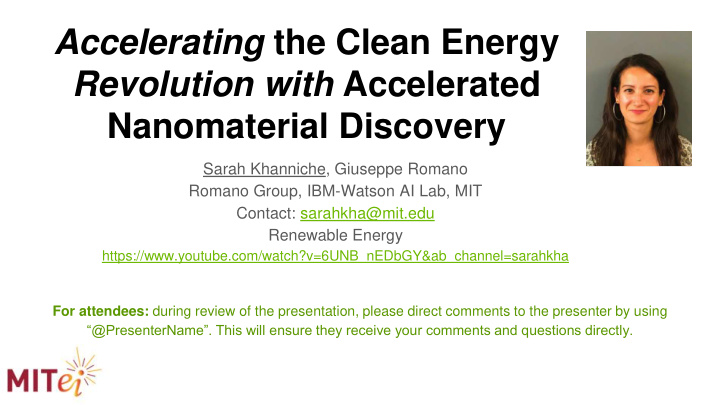



Accelerating the Clean Energy headshot Revolution with Accelerated Nanomaterial Discovery Sarah Khanniche, Giuseppe Romano Romano Group, IBM-Watson AI Lab, MIT Contact: sarahkha@mit.edu Renewable Energy https://www.youtube.com/watch?v=6UNB_nEDbGY&ab_channel=sarahkha For attendees: during review of the presentation, please direct comments to the presenter by using “@PresenterName”. This will ensure they receive your comments and questions directly.
Introduction Thermoelectric (TE) materials have attracted great attention in a wide range of applications and play a growing role in the clean energy revolution solar panels wearable devices cooling spacecrafts and automotive TE materials systems power generation Conversion of waste heat However, the efficiency of thermoelectric devices is yet to be sufficient for a widespread use
Introduction (slide 2) TE materials convert waste heat directly into electricity without greenhouse gas emissions Figure of merit ( ZT ) Waste heat Seebeck electrical coefficient conductivity TE materials 𝑈𝝉𝑇 2 𝑈𝝉𝑇 2 𝑎𝑈 = = 𝛌 𝝀 𝒇 +𝝀 𝒒 total thermal electronic and phonon Electrical conductivity thermal conductivity energy Realizing high TE performance requires High ZT ≥ 3 developing materials that conduct electricity but block heat from phonons (high ZT )
Objective Nanoporous materials are of great interest for thermoelectric applications because they can conduct electricity easily, but block heat conduction Nanoporous materials Pores randomly oriented? Pore arrangement ? Aligned pores? affects the efficiency of TE Optimum pore distribution? nanomaterials Pores = block heat(phonons) Efficiency Nanomaterial optimization is a very This work aims to optimize a 2D Si nanomaterial challenging task. to achieve low thermal conductivity . Identifying suitable pore patterns for every new material is To accelerate the discovery of novel pore patterns by combining extremely difficult to achieve machine learning with heat transport calculations
Methods This methodology is powerful to build a cheaper surrogate model to OpenBTE Solver accelerate material optimization Thermal random pores Set of Conductivity configurations expensive PDEs ( f ) f ( x 1 ), f ( x 2 ), …, f ( x N ) ( x 1 , x 2 , …, x N ) Collect of a set of training data N =10 Gaussian f ( x 1 ), f ( x 2 ), …, f ( x N ) Process Addition to the training set Learn from previous calculations Definition of a cheap Select new x Surrogate model, f ’ with lowest Repeated iteratively expected loss f ( x ) ~ f’ ( x ) For a given number of times (X 200) Acquisition Function (Expected Improvement) Evaluate f ’ at new pore configuration f ’ (new x ) returns the optimal pore configuration
Results 5 novel pore patterns are presented in this work Zigzag Unit cell Unit cell Scattered 2 1 Unit cell Unit cell Butterfly Unit cell Lozenge Rectangular 4 5 3
Results (slide 2) The “scattered” and “zigzag” patterns decrease the thermal conductivity ( κ eff) below 10 W/m/K 1 The Scattered pattern 2 The Zigzag pattern Scattered Side solitary pores pores Zigzag Large pattern central pore Pore Pore Cluster Cluster κ eff = 8.9 W/m/K κ eff = 6.1 W/m/K
Results (slide 3) The “lozenge”, “butterfly” and “rectangular” patterns decrease the thermal conductivity ( κ eff) below 5 W/m/K 3 4 5 The rectangular pattern The Lozenge pattern The butterfly pattern Aligned solitary Central solitary Isolated pores pores pores Contactless Pores well Pore pores packed Island cross shape Set of 2 Interconnected pores κ eff = 4.0 W/m/K κ eff = 4.9 W/m/K κ eff = 2.8 W/m/K
Conclusions Nanomaterial optimization is a very challenging task . Combining thermal transport calculations with machine learning accelerate the discovery of new pore distribution. Many novel pore patterns were identified in this work. We presented 5 of them. Pores can be found in clusters, very close to each others. Other pores are not connected to each others → publication in preparation ↑ Efficiency Scattered Butterfly Lozenge Zigzag Rectangular 8.9 6.1 4.9 4.0 2.8 ↓ κ eff in W/m/K Nanomaterial discovery represents a key strategy in fighting climate change
Recommend
More recommend